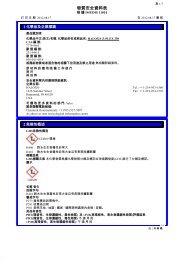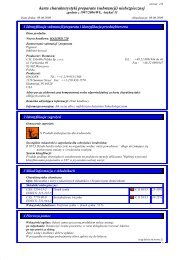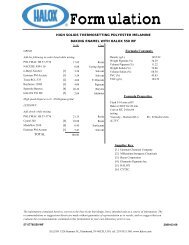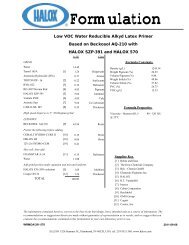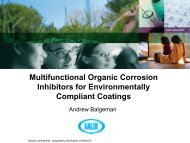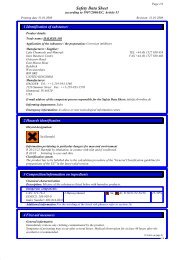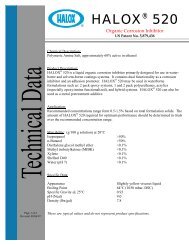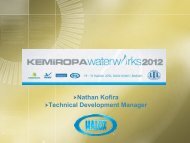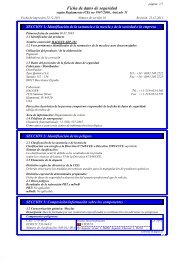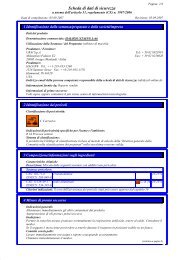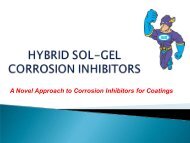Formulating novel aqueous epoxy - Halox
Formulating novel aqueous epoxy - Halox
Formulating novel aqueous epoxy - Halox
- No tags were found...
You also want an ePaper? Increase the reach of your titles
YUMPU automatically turns print PDFs into web optimized ePapers that Google loves.
Mike Cook, technical managerfor the Epoxy Curing AgentsApplications Group, obtained aB.Sc in Chemistry and a Ph.D inorgano-fluorine chemistry atBirmingham University beforejoining Air Products. As well asworking in Utrecht, Mikeworked in the U.S. for threeyears on a research assignmentwhere he developed new <strong>epoxy</strong>curing agents for 2 packwaterbased systems.<strong>Formulating</strong> <strong>novel</strong> <strong>aqueous</strong><strong>epoxy</strong> resin systems for metalprimer applicationsAuthor:Dr Michael CookPresented by: Dr. Michael CookTechnical Manager EuropeCompany:Air Products and Chemicals Inc.c/o Kanaalweg 15, PO Box 31933502GD, Utrecht, The NetherlandsTelephone: +31.30.285.7100Fax: +31.30.285.7111E Mail:cookmi@apci.comPaper presented at the 6th Nürnburg Congress April 2001
increase but rather by decrease in performanceproperties such as a loss of gloss or a loss ofcorrosion protection. Typical properties of coatingsbased on these technologies are summarized inTable 1 below:Table 1: Comparison of Type Iand Type II SystemsType I Type IIProperty Liquid Epoxy Solid EpoxyEpoxy EquivalentWeight (EEW) 175-240 450-750VOC (g/l) 0 100-300Typical Pot Life 1-2 hours > 4 hoursTypical Drying Speed Slow FastKey Drying ChemicalMechanism Reaction Lacquer DryThe contents of the paper will demonstrate howrecent changes in both the curing agent and <strong>epoxy</strong>resin chemistry have lead to the successfuldevelopment of coatings for use in metalapplications.Curing Agent Chemistryfor Type I TechnologyThe nature of the amine hardener for Type Isystems serves a dual purpose. Initially it acts asan emulsifying agent for the liquid <strong>epoxy</strong> resin inthe <strong>aqueous</strong> environment, and secondly it acts asa cross-linker. The degree and nature of the crosslinkingthus giving rise to the ultimate performanceproperties of the coating. There are three generictypes of curing agents, which have the chemicalstructure required to carry out these roles. Theproducts concerned are (a) amidoamines 1:condensation reaction products betweenmonomeric, C 18fatty acids andpolyalkyleneamines, (b) polyamides 2: acondensation reaction between C 36dimer fattyacids and polyalkyleneamines and (c) amineadducts 3: reaction products between an amineand an <strong>epoxy</strong> resin.The base performance of products 1-3, suffer fromsome inherent weaknesses, most common beingpoor resin compatibility leading to short pot lives,coupled with coatings that exhibit inferior waterresistance when compared to their solvent bornecounterparts. Modifications to the above structuresand the techniques adopted during manufacture,has proved to be a major factor in the developmentof new products that address these deficiencies.The most common method of modification involvesreducing the primary amine content. This approachalso serves a dual role. First, the overall reactivityof the curing agent is reduced, which is beneficialfor extending the pot life of the system and second,is to dramatically improve the compatibility of thecuring agent with the <strong>epoxy</strong> resin. Typicalapproaches at reducing the primary amine contentinvolve reacting 1-3 with mono glycidyl ethers 4 ,formaldehyde or with unsaturated compoundssuch as acrylonitrile, 5 which are capable ofundergoing Michael addition reactions.Although modifications improve the compatibilityof the amine hardener with the <strong>epoxy</strong> resin, thewater solubility of the curing agent decreases andquite often the addition of an organic acid such asacetic acid is required to maintain a stable <strong>aqueous</strong>solution. Depending upon the level and nature ofthe acid employed, it can remain entrapped withinthe cured film and therefore result in a decreasein the water resistance and corrosive propertiesof the cured coating. The presence of acidic saltingagents is also known to contribute to thephenomena of flash rusting. For these reasons, anymodification employing organic acids must be keptto an absolute minimum.Novel Curing AgentTechnologyA new class of waterbased curing agent (Epilink ®701) has been developed. 6 The product is a highmolecular weight aliphatic amine emulsionsupplied at 55% solids in water. The product readilyemulsifies liquid <strong>epoxy</strong> resins and in addition, thehigh molecular weight of the curing agent producesvery fast dry times which are comparable to thoseobserved with high VOC solvent borne coatings.By combining the drying properties of the curingagent with the good film formation properties ofliquid epoxies, it is now possible to obtain goodwater resistance and good wet adhesion in alacquer dry, zero VOC formulation. A key featureof the emulsified curing agent is the fact that ithas been specifically developed to eliminate theeffect of flash rusting, a feature all too commonwith existing waterbased <strong>epoxy</strong> technology. Theability of formulated coatings not to exhibit thisphenomena, thus makes the curing agent an idealproduct for use in 2 pack waterbased metalprimers.Formulations based onNovel Curing AgentAnti-corrosion resistance primers and high glossmetal enamels have been developed using Epilink ®701. (see Appendix I & II for start pointformulations). Formulation attributes for the twocoatings are presented in Table 2.Table 2: Formulation AttributesAnti-Corrosive High-GlossMetal Primer Metal EnamelProperty (ACP01) (HGE01)VOC (g/l) 0 0Mix Viscosity (mPa.s) 500 1000Weight Solids (%) 63.0 59.4Volume Solids (%) 47.5 47.3PVC (%) 30.0 15.6Resin Stoichiometry(Epoxy:Amine) 1.0:1 1.0:1For highest performance it is extremely importantto ensure a high level of compatibility is achievedbetween the amine curing agent and <strong>epoxy</strong> resin.Optimum performance properties are obtainedusing either a liquid Bisphenol A <strong>epoxy</strong> resin or ablend of Bisphenol A/F resins diluted with anaromatic glycidyl ether.The preferred diluents are cresyl glycidyl ether andp-t-butylphenyl glycidyl ether. End of pot life isdetermined by an increase in viscosity, which isclearly visible to the applicator. Residual paintforms a solid gel overnight for easy waste disposal.Air Products PLC Paper presented at the 6th Nürnburg Congress April 2001
For metal primer applications, optimum results forcoatings based on Epilink ® 701 are obtained forprimers with a PVC in the range of 30-35%.Preferred anti-corrosive pigments include <strong>Halox</strong>SZP 391, <strong>Halox</strong> SW-111 and Heucophos ZMP,which can be added to paint formulations at 60-100g/l. Extender pigments are selected to give avariety of particle shapes and good filler packing.Epilink ® 701 is an excellent pigment wetter sopigments can be ground into the curing agent side,without the need for additional pigment dispersingaids.Novel Epoxy ResinTechnologyAn <strong>epoxy</strong> resin dispersion, (Ancarez ® AR550) hasbeen developed which incorporates the bestcharacteristics of both Type I and Type II systems 7 .The unique chemistry of this <strong>epoxy</strong> resin enablesthe formulation of a Type II system that retains theadvantages of such systems including high <strong>epoxy</strong>equivalent weight (EEW), long pot life and fastlacquer dry. Coatings based on this new resin alsoexhibit desirable performance attributes previouslyonly found with Type I waterborne <strong>epoxy</strong> systemsincluding zero VOC and lower cost-in-use.Important aspects of the <strong>epoxy</strong> resin’s propertiesinclude its volume average diameter (D v) of 0.5microns, consistent with other high-quality Type IIdispersions. Particle size in Type II systems isimportant for two reasons. First, overall particlesize distribution impacts film formation, emulsionstability and emulsion viscosity. Second, becausethe curing agent must penetrate and react withthe <strong>epoxy</strong> resin in Type II systems, the smaller theparticle size the greater the overall surface areaof all the particles, and hence, the greater theopportunity for reaction between the curing agentand the <strong>epoxy</strong> resin. Typical properties for the newresin dispersion are given in Table 3.Table 3:Resin Dispersion PropertiesAppearance, liquidMilky whiteAppearance, filmClear, GlossySolids content (wt. %) 55SolventwaterViscosity @ 25 °C (mPa.s) a 100Specific Gravity @ 25 °C 1.09Epoxy Equivalent Weight(EEW, g/eq) b712 on solidsVolume Average Diameter(D v, microns) 0.5a Brookfield viscosity, Spindle #3, 12 rpm, bEmpirical calculationAnother important property of the Ancarez ® AR550resin is its molecular weight distribution. Molecularweight distribution impacts film formation, intraparticleviscosity and cure kinetics in waterborne<strong>epoxy</strong> systems. The unique manufacturing processof Ancarez ® AR550 resin leads to a significantlylarger percentage of lower molecular weightmaterial than other established Type II soliddispersion resins. This allows Ancarez ® AR550resin to coalesce without the aid of co-solvents.Thus Ancarez ® AR550 resin can be readilyformulated to zero or low VOC coatings whileretaining the film formation characteristics of TypeII systems.Formulations based onNovel Resin TechnologyCoatings were formulated to evaluate theperformance of the Ancarez ® AR550 resin in twocomponent ambient cure <strong>epoxy</strong> systems. Thesystems evaluated include a low-VOC,anticorrosive metal primer and an ultra-low VOC,high gloss metal enamel 8 , (Appendix I & II).Formulation attributes for the two coatings arepresented in Table 4.Table 4: Formulation AttributesAnti-Corrosive High-GlossMetal Primer Metal EnamelProperty (ACP02) (HGE02)VOC (g/l) 76 6Mix Viscosity (mPa.s) 500 1000Weight Solids (%) 61.0 58.7Volume Solids (%) 47.1 47.8PVC (%) 30.0 15.5Resin Stoichiometry(Epoxy:Amine) 0.8:1 1.15:1Three important factors need to be considered whenformulating Type II waterborne epoxies, these include:(a) coalescence, (b) stoichiometry and (c) stability. Aspreviously mentioned, good coalescence is critical foruniform film formation and for good barrier properties.Ancarez ® AR550 resin exhibits very good coalescencewhen used with either Anquamine ® 401 orAnquamine ® 419 curing agents. To further improveproperties such as gloss or pot life, aromatic <strong>epoxy</strong>diluents such as Epodil ® 742 (cresyl glycidyl ether)can be added to the Ancarez ® AR550 resin atapproximately 5% (w/w).Changing the curing agent to <strong>epoxy</strong> resinstoichiometry is a valuable formulation tool. Foroptimum corrosion protection, 20-40% excess<strong>epoxy</strong> resin is desirable. Faster propertydevelopment, in terms of dry speed and hardnessbuild up are obtained when 10-20% excess curingagent is employed, whereas a good balance ofproperties is obtained at 1:1 stoichiometry.Pigments or high levels of dilution can de-stabilizeeither the <strong>epoxy</strong> side of the formulation or thecuring agent side of the formulation. Whenpigmenting the <strong>epoxy</strong> dispersion, a suitabledispersing agent dispersant should be added toavoid agglomeration of the <strong>epoxy</strong> particles. Whenpigmenting the curing agent side of theformulation, small amounts of acetic acid (0.2-0.5% based on curing agent weight) can assist inimproving water solubility and avoid separation.This is especially true when formulating withhydrophobic curing agents.Coating and PanelPreparationThe two components of the paint formulation arebest mixed at high viscosity and then let down withwater to the desired application viscosity. Saltspray and prohesion tests were conducted oncoatings spray applied on to shot blasted steel (50microns profile). The coatings (75-100 micronsDFT), were allowed to cure seven days at ambienttemperature before testing. Bonderite 1000 panelswere used for humidity and Electrochemical (EIS)testing.Handling andPerformance Results ofWaterbased EpoxyCoatingsPot Life Characteristics: Pot life profiles are verymuch dependent upon the type of resin technologyutilized. Formulations based on Epilink ® 701exhibit the typical Type I viscosity profile, moderaterise during the working life, followed by a morerapid rise leading to gelation. This usually occursafter 3-4hrs from the initial point of mixing.The two coating formulations based on Ancarez ®AR550 exhibit longer pot lives (4-6hrs). Viscositychanges over the pot life are minimal, with no signof gelation occurring even after 24hrs. Pot life ofcoatings based on Ancarez ® AR550 is viewed asthe point where significant changes in gloss startto occur, resulting in its decreasing ability tocoalesce. Pot life profiles via viscosity and glosschanges are given in Figures 1 & 2Air Products PLC Paper presented at the 6th Nürnburg Congress April 2001
Figure 1: Pot Life via ViscosityTable 5 clearly highlights some of the fundamentaldifferences between the liquid resin and solid resindispersion technology. Coatings based on the <strong>novel</strong>resin dispersion exhibit rapid dry times (< 30mins), whereas tack free times for coatings basedon liquid resins cured with the new curing agentemulsion are slightly longer, taking ~ 90 mins toreach the same physical state. Ancarez ® AR550also gives rise to softer films compared to Epilink ®701; however, coatings based on the solid resinpossess a higher level of flexibility. This isdemonstrated by an improvement in both the directand reverse impact resistance values. All coatingsexhibited excellent adhesive properties overphosphate treated steel; with no significant lossof adhesion being observed after panels hadundergone 24 hrs exposure to constant humidity.Corrosion Resistance Properties: Anti-corrosiveprimer formulations were also subjected toaccelerated weather testing. Tests included longterm exposure to salt spray, condensing humidityand prohesion. Results of the weathering studyare given in Table 6.Table 6: Accelerated WeatherTesting (1000 hrs exposure)Salt Fog a Prohesion bFormulated Scribe/ Scribe/ HumidityCoating Field Field FieldACP01 (Liquidresin system) 10/10 7/10 10ACP02 (Solidresin system) 9/10 7/10 10ConventionalSolvent BasedPrimer c 10/10 9/10 10a. ASTM D117-90, b. ASTM B85-94, ASTM D-1654ratings, c. Ancamide 260A/liquid <strong>epoxy</strong> resinField Blisters & Scribe : 10 - best, 0 – worstThe data presented in the table above clearlyindicates that the anti-corrosive primers based onboth types of waterbased systems can deliverexceptional, long term corrosion protection. After1000hrs exposure, no signs of field blistering wereobserved on the panels under test. Salt spray andhumidity resistance are excellent. Figure 3 depictsphotographs of the panels based on ACP01following 1000hrs salt spray & prohesion exposure.Figure 2: Pot life via GlossBase Performance Properties: Standardperformance properties including hardnessdevelopment, cross hatch adhesion, and the directand reverse impact resistance were also conductedon the coating formulations. Results from thesetests are summarized in Table 5.Table 5: Waterbased Coatings PropertiesDirect ReverseDry Persoz Dry Wet Impact ImpactCoating Formulation Times a Hardness Adhesion Adhesion b cm.kg cm.kgAR550 Metal Primer (ACP02) 30 mins 140 5B 5B 30 6AR550 Metal Enamel (HGE02) 30 mins 190 5B 4B 65 6E701 Metal Primer (ACP01) 85 mins 220 5B 5B 25 4E701 Metal Enamel (HGE01) 95 mins 300 5B 5B 50 4a: Set to touch, b: 14 day cure; 1 week Cleveland Humidity exposure, ASTM D3359Air Products PLC Paper presented at the 6th Nürnburg Congress April 2001
Figure 3: Epilink ® 701 Metal Primer (ACP01) PanelsFollowing 1000hrs Accelerated Weather TestsSalt SprayProhesionData obtained during the prohesion study tends toindicate waterbased coating technology is moreprone to scribe damage when subjected to thisaggressive, cyclic test programme. Overall, theanti-corrosive properties of the waterbasedcoatings are comparable in performance to theresults obtained for conventional solvent basedpolyamide primers.Early Rain Evaluation: The anticorrosive metalprimer and high-gloss metal enamel based on theAncarez ® AR550 resin were evaluated for early rainresistance by periodically applying de-ionizedwater to sections of a freshly applied coating.Coatings were judged to be rain resistant whenthey exhibited complete resistance to blistering andsoftening and only slight decrease in gloss wasobserved.This evaluation revealed that after a cure of only2-3 hours (see Table 7 below) the coatings wereresistant to rain. Competitive Type II waterborne<strong>epoxy</strong> systems where high levels of co-solvent arerequired for good film formation need over 6 hoursof cure time to achieve an equal degree of rainresistance.Table 7: Summary of early rainevaluation of AR550 coatingsEarly RainFormulationResistanceAnticorrosive Metal Primer (ACP02) 3 hoursHigh-Gloss Metal Enamel (HGE02) 3 hoursCompetitive Type IIWaterbased Resin Primer 6 hoursPerformance Evaluationusing ElectrochemicalImpedance SpectroscopyElectrochemical Impedance Spectroscopy (EIS) isa relatively new technique for measuring thebarrier properties of coatings. EIS experiments aretypically 24 hours in duration and correlate wellwith long term tests such as salt fog and prohesion.As shown in Figure 4, EIS involves exposing acoated steel panel to a salt water solution. A lowAC voltage is applied to the steel panel. Theelectrical current that passes through the coatinginto the salt water is measured.By varying the frequency of the AC voltage, coatingperformance can be measured. Key propertiesinclude the water uptake of the coating(capacitance) and the resistance of the coating toion penetration (pore resistance).Figure 4:Electrochemical impedance spectroscopy cellResistance (Log Modulus [ohm]) is graphed vsfrequency which provides all the appropriateinformation. A good barrier coating will exhibitlow water uptake and high resistance to ionpenetration, whereas a poor coating will exhibithigh water uptake and very low pore resistance.Illustrations of the various types of EIS plots aregiven in Figure 5.EIS Plots for WaterbasedPrimersThe anticorrosive metal primers using Epilink ® 701and Ancarez ® AR550 were each spray applied (75-100 microns DFT) to shot blasted steel panels (50microns profile). Using a Gamry FAS1 Potentiostatwith EIS 900 software, measurements were takenafter 1hr and 24 hrs of immersion in 1 M NaClsolution for both formulations.Figure 6: EIS Plot for ACP01Figure 7: EIS Plot for ACP02Electrochemical impedance data for the Epilink ®701 metal primer (Figure 6), highlights theexcellent electrochemical resistance propertiesthat can be obtained with Epilink ® 701 in a Type Iwaterbased <strong>epoxy</strong> coating. The data shows thatthe coatings are highly resistant to ion penetrationwith a very low water uptake. Pore resistancevalues of 10 9 Ohms and capacitance values of
SummaryInnovative Type I and Type II waterbasedtechnology has been developed that leads to highperformance, ambient cure <strong>epoxy</strong> coatings. Typicalindustrial maintenance coatings developed fromeither the <strong>novel</strong> solid resin dispersion or from aliquid resin plus the new curing agent emulsiontechnology, were shown to deliver exceptionalperformance characteristics, compared to existingwaterbased and solvent based systems. Basedon the performance evaluations that have beenconducted to date, the above products offer anticorrosiveproperties, which make them ideal for awide range of industrial metal protectionapplications.References1. Walker, F.H; Cook, M.I; Two ComponentWaterborne Epoxy Coatings, ACS SymposiumSeries 663 Technology for Waterborne CoatingsJ. Edward Glass Editor, 1997 The AmericanChemical Society2. Walker, F.H.; Shaffer, O.; in Provder, T. (ed.), FilmFormation in Waterborne Coatings, ACSSymposium Series #648, Washington D.C.,1996, pp. 403-4173. Hoechst Technical Bulletin “Waterbased 2-Pack-Systems” GES 2907.e, Edition:8/19934. Shimp, D.A., US Patent 4,246,148, 1981.5. Becker, W.; Karasmann, H. US Patent4,197,389, 19806. Klippstein, A. World Patent WO93/21250, 19937. Dubowik, D. A, Ross, G. C; Paint and CoatingsIndustry, Oct 1999, 60-72.8. Ancarez ® AR550 Waterborne Epoxy ResinTechnical Bulletin; Air Products and ChemicalsInc:Appendix INew Waterborne Systems – Anti-corrosive Primer FormulationsWaterborne Epoxy Primer based onEpilink ® 701 Curing Agent (ACP01)A SidegDow DER 331 154.4Cresyl glycidylether 38.6Total 193.0B SideEpilink ® 701 300.6Surfynol DF62 2.6Disperbyk 190 13.1Deionized water 204.3Red Iron Oxide 77.7Barium sulphate 177.610ES Wollastocoat 111.0Talc (LVT400) 99.9<strong>Halox</strong> SZP391 55.5Total 1043.0Properties:Volume solids 60.5%Weight solids 72.5%PVC 33.5%VOC0 g/litreMixing ratio (A:B)1:4 (vol)Pot life3 hoursWaterborne Epoxy Primer based onAncarez ® AR550 Epoxy Resin (ACP02)A SidegDeionized water 126.8Disperbyk 190 12.5Surfynol DF110D 3.0Mica 10.010ES Wollastocoat 65.0<strong>Halox</strong> SW-111 100.0Red Iron Oxide 75.0Barium Sulphate 65.0Zeospheres 400 65.0grind to Hegman 5 then add:Ancarez ® AR550 430.0Dowanol PM 3.0Acrysol RM-8W 11.0Total 966.3B SideAnquamine 419 117.5Deionised water 58.9Total 176.4Properties:Volume solids 47.1%Weight solids 61.0%PVC 30.0%VOC76 g/litreMixing ratio (A:B)4:1 (vol)Pot life4 hoursAppendix IINew Waterborne Systems - White Gloss Enamel FormulationsWaterborne Epoxy Enamel based on Epilink ®701 Curing Agent (HGE01)A SidegEpires ER8 25.0Total 25.0Waterborne Epoxy Enamel based onAncarez ® AR550 Epoxy Resin (HGE02)A SidegAncarez ® AR550 595.0Acrysol RM-8W 2.1DI Water 8.8Total 605.9B SideEpilink ® 701 40.0Bentone EW 3% in water 1.0Borchigol VL73S 0.4Surfynol 420 0.1Foamex 815 0.2Kronos 2160 25.0Blanc Fix Micro 15.0Talc 10M2 2.0DI water 16.4Total 100.0B SideDI Water 70.0Surfynol DF62 3.5Anquamine 401 80.1Glacial acetic acid 0.5TiPure R706 250.0Surfynol 420 1.5Dowanol PM 3.0Acrysol RM2020 2.0Acrysol RM-8W 12.0Total 472.6Properties:Volume solids 50.5%Properties:Volume solids 47.8%Weight solids 71.4% Weight solids 58.7%PVC 20.5% PVC 15.4%VOC0 g/litre VOC6 g/litreMixing ratio (A:B)1:4 (w/w) Mixing ratio (A:B)2:1 (vol)Pot life2 hours Pot life4 hoursAir Products PLC Paper presented at the 6th Nürnburg Congress April 2001
For more informationFor additional information, pleasecontact Air Products at the followinglocations, or e-mail our Europeantechnical experts at:<strong>epoxy</strong>box@airproducts.com.Air Products (Chemicals) PLCClayton LaneClaytonManchester M11 4SREnglandTel +44 161 230 4265Fax +44 161 223 4753Chemicals Division EuropeAir Products Nederland B.V.Kanaalweg 15PO Box 31933502 GD UtrechtThe NetherlandsTel +31 30 285 7100Fax +31 30 285 7111Air Products c/o Anchor Italiana SPAVia Rismondo N427100 PaviaItalyTel +39 0382 539982/3/4Fax +39 0382 308462Air Products France78 Rue Championnet75018 ParisFranceTel +33 144 92 52 95Fax +33 144 92 52 91Air Products and Chemicals, Inc.Performance Chemicals7201 Hamilton BoulevardAllentown, PAUSA18195-1501Tel +1 800 345 3148or +1 610 481 6799Fax +1 610 481 4381Air Products Singapore Pte Ltd9 Temasek Boulevard#08-02 Suntec Tower 2Singapore 038989Tel +65 332 1610Fax +65 332 1601Air Products Japan, Inc.Shuwa No. 2Kamiyacho Bldg., 11FI3-18-19, ToranomonMinato-KuTokyo 105JapanTel +813 3432 7031Fax +813 3432 7052Air Products South Africa (Pty) Ltd3 Protea PlaceSandtonPrivate Bag 784090Sandton 31116South AfricaTel +27 11 884 7474Fax +27 11 322 0401Air Products Australia Pty Ltd2/20 Hunter StreetRO. Box 4068Parramatta NSW 2124AustraliaTel +61 2 687 1944Fax +61 2 687 1950tell me morewww.airproducts.com© Air Products and Chemicals, Ind. 2001 L5843



